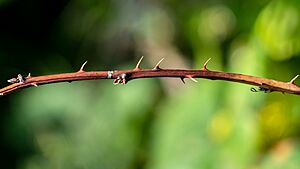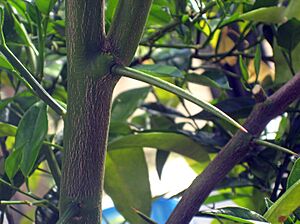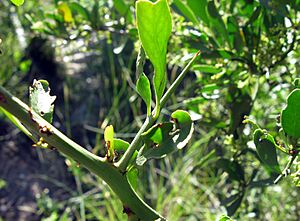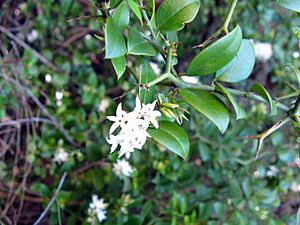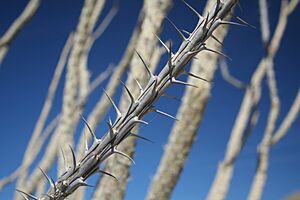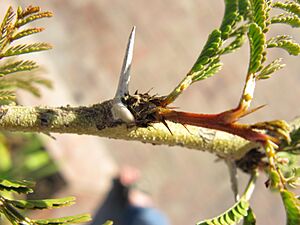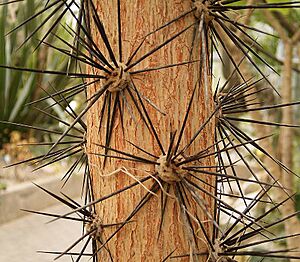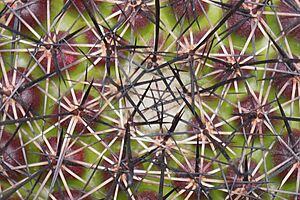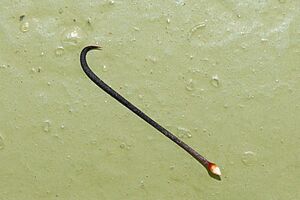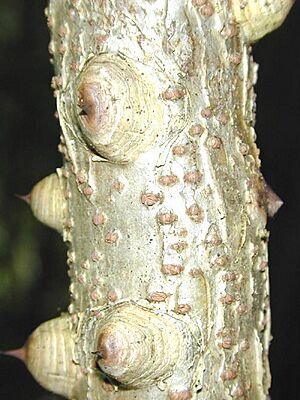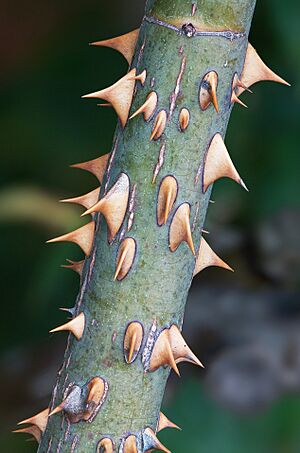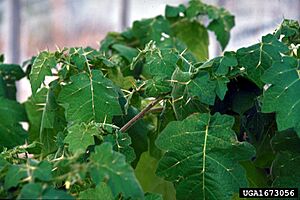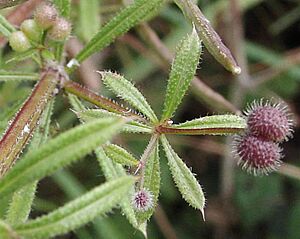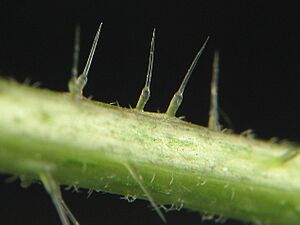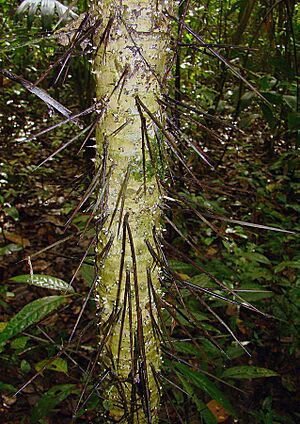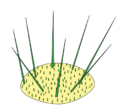Thorns, spines, and prickles facts for kids
Have you ever touched a plant and felt something sharp? Those sharp parts are usually called thorns, spines, or prickles. These are hard, stiff parts of a plant that have sharp ends. Their main job is to protect the plant by stopping animals from eating it. Think of them as the plant's natural bodyguards!
Contents
What are Thorns, Spines, and Prickles?
While we often use these words to mean the same thing, plant experts have special definitions for each. Knowing the difference helps us understand how plants grow and protect themselves.
Thorns: Modified Stems
Thorns are actually modified branches or stems. This means they grow from the same places a new branch or leaf would. They can be simple or have smaller branches themselves. Because they are part of the stem, they have special tubes inside called vascular bundles, which carry water and nutrients.
Spines: Modified Leaves
Spines are modified leaves, or parts of leaves. They can also be modified stipules, which are small leaf-like structures at the base of a leaf stalk. Like thorns, spines also contain vascular bundles, making them firmly attached to the plant.
Cacti are famous for their spines! Some cacti also have tiny, barbed spines called glochids. These are very small and can easily break off and stick in your skin.
Prickles: Skin Outgrowths
Prickles are different because they grow from the outer layer of the plant, called the epidermis, and the layer just beneath it, the cortex. They do not have vascular bundles inside. This means they can be removed more easily and cleanly than thorns or spines. Think of rose bushes – what we often call "thorns" on a rose are actually prickles!
Why Do Plants Have Sharp Parts?
The main reason plants have thorns, spines, and prickles is for protection. They are a physical defense against animals that want to eat them. Imagine trying to eat a plant covered in sharp points – it would be very uncomfortable!
These sharp structures also have other uses:
- Shade and Insulation: Some spines can help shade the plant from too much sun, keeping it cool. Others can help insulate the plant, keeping it warm in cold weather. For example, the spines on a saguaro cactus shade its growing tip in summer.
- Water Collection: In some desert plants, spines can help collect dew or fog, directing water down to the plant's roots.
Other Sharp Plant Structures
Besides thorns, spines, and prickles, plants have other sharp parts:
Spinose Teeth and Apical Processes
Some leaves have sharp points along their edges, called spinose teeth. If the very tip of a leaf is sharp and stiff, it's called a spinose apical process.
Trichomes (Hairs)
Trichomes are tiny, hair-like growths on the plant's surface. They are much smaller and less rigid than prickles. Some trichomes are stiff and sharp, like bristles, and can deter small insects. Others, like those on stinging nettles, are called stinging trichomes and can inject irritating chemicals.
Root Spines
Believe it or not, some plants even have spines that grow from their roots! These are often found on the trunks of certain palm trees, like the "Root Spine Palms" (Cryosophila species). These root spines also help protect the plant.
How Do These Structures Evolve?
Scientists think that thorny structures might have first developed in plants growing in sandy places. In these areas, it's hard for plants to grow back quickly if they get damaged. So, having sharp defenses would have been very helpful to protect themselves from being eaten.
How Humans Use Spiny Plants
People have used plants with thorns, spines, or prickles for a long time.
- Natural Fences: They are often planted around homes or properties to deter burglars. Imagine trying to climb through a hedge of thorny plants!
- Protecting Crops and Animals: Farmers have used them to protect their crops and livestock from wild animals. Examples include hawthorn hedges in Europe or agave plants in the Americas.
Images for kids
See also
 In Spanish: Espina (botánica) para niños
In Spanish: Espina (botánica) para niños
- Areole
- Glochid
- Trichome
- Plant defense against herbivory


